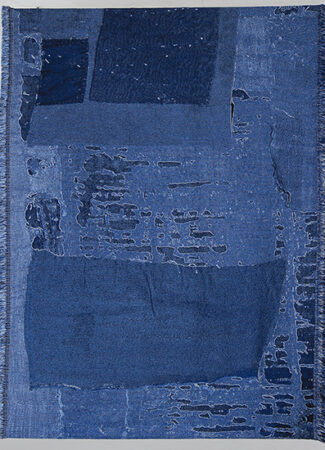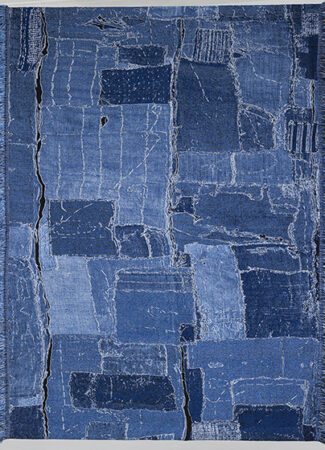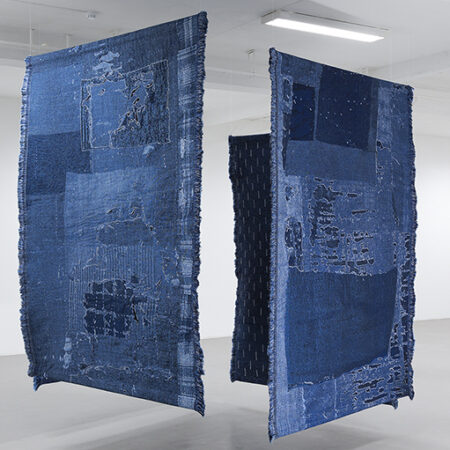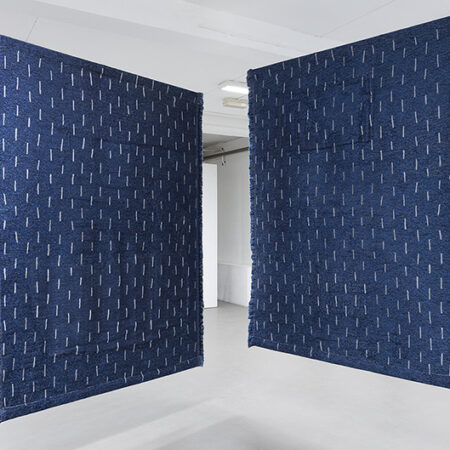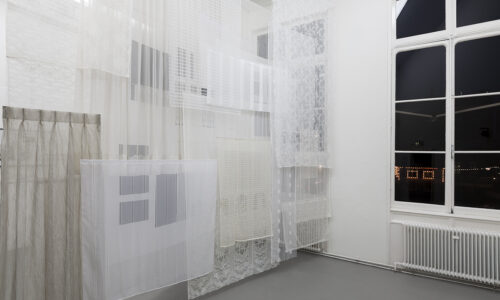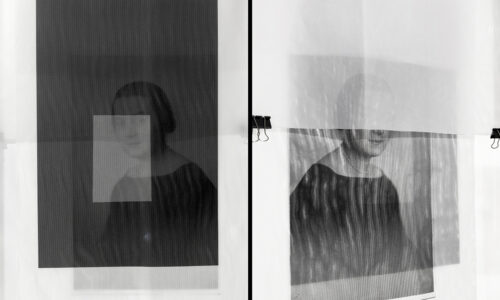I describe my work as extended still lifes
Swedish textile artist Charlott Markus is based in Amsterdam. She “often uses materials as complex carriers of meanings, memories and emotions,” and employs a range of techniques often working with layers to construct collages where the front and back have equal importance.
What is your background in textiles?
I actually have my base in photography and have a diverse education that started out with psychology and theology studies at Lund’s university to later merge into a photographic art education where I graduated at the Gerrit Rietveld Academy in Amsterdam. Textiles started to appear early in my photographs and in my installation works. First with carpets and discarded, found and collected textiles and nowadays I even produce textiles myself when it fits the project that I am working on. I find it important to know where my materials come from and I also prefer to be able to produce my works myself or at least master and understand the different techniques that I use for my work.
What is it about textiles as an art form that appeals to you?
My first appeal for textiles was the historical context and the specific narratives the textiles I used were carrying. Learning about new techniques and traditions regarding weave, patchwork, stitching and layering is a growing interest of mine and it feels important to connect the present-day to history and traditions. Since I often use my materials as complex carriers of emotions and meaning it made perfect sense at one point to also start making my own textiles.
What techniques do you use?
What techniques I am using have been developing sort of naturally, where I learn as I go. I often work with layers in a collage like form so both layers and transparency often comes about in my works, where both fronts and backsides can have equal importance. When working with textiles I use both hand and machines techniques but tending more and more to working mostly with my hands these days. Weaving, stitching, embroidery, printing, layering and lately also dying is all on my pallet. It is first in the last years that I am actually learning to weave myself and next to this developing my own form of hand embroidery that I call scar embroidery.
Tell me about Partition #7 (Femme Blueprint)
‘Partition #7 (Femme Blueprint)’ is a collaboration with the Textile museum in Tilburg. The work is made on a digital jacquard loom whereas I nowadays work mostly on a manually operated loom in my studio.
With Partition #7 (Femme Blueprint)’ the back and front sides were woven simultaneously as one piece, which added the extra layer of ghost images on the different backsides. All the backsides are midnight blue and have a repetitive almost cartoon-esc pattern that resembles falling rain or tears. These repetitive details are woven with silver thread appearing like expensive ‘railroad scars’. The pattern itself is inspired by old hand-made stitches from a dust rag, sown by an anonymous woman. On the front side where we encounter a more narrative image, which bear the resemblance of blueprints, one can find the warp threads being visible in white contours creating scar-like borders and lines. This work is abstract pieces based on narratives of women, inspired by stories that are dictated by the many hidden ‘structural blueprints’ that our societies are built on.
The work is based on my observations and research when I was an artist in residence in Japan 2019. I had the pleasure to work with the original textile pieces in the extensive boro collection of ethnologist Chuzaburo Tanaka. My focus point was on the map like patterns that stitches and patches can form together and later my observations and sketches were translated into weaving patterns, which is a play with many different bindings and blue hues to create an interaction with the abstract map like shapes. Working with a digital jacquard loom for pieces that are inspired by the sustainable layered and very crafty handwork such as boro made total sense to me since it adds a layer. A layer that points to how much the general textile production and labor has changed with times.
How do you describe your work?
In a way my work often has a photographic starting point and I describe my work as ‘extended still lifes’. I explore possibilities and limitations of the image and create new stories where I use materials as complex carriers of meanings, memories and emotions. In a dramaturgical way, I create an alternative space where the margins between photography, painting and sculpture are intertwined; I always zoom in at the same time as I examine the whole. The way I work not only examines space, color and form but is also a direct exploration of relationships with an emphasis on hidden structures, identity and equality.
How do you create a piece?
I often sketch but also important in the process is all the notes and snapshots that I make and sometimes I make small models.
Where do you work?
I work in my studio or on location. My studio in the centre of Amsterdam became a clean studio space where I work with textiles and photography projects. For the more messy or dirty steps like woodwork and dying of textiles I share a space in the studio of my partner. I have also been blessed with a primitive forest plot where I have been weaving, dyeing textiles and photographing the last couple of years.
I know this is a hard question but how long does a bigger piece take?
That depends on where you start counting, when the ideas start to flicker through your brain? When you stomach tells you this is a (or the right) direction to go? When you start to make first sketches or models? When you start producing the final piece?
For the four big weaves I developed in collaboration with the Textile Museum in Tilburg it started with inspiration on Mondriaan fund’s artist-in-residence in Japan. First I researched, then I sketched and then there was the research to see what was possible for being able to make the piece. When it was finally clear I was going to collaborate with the Textile Museum on this specific work a period of development days with an expert of the museum was planned in. Trial and error led to the final choices of materials and bindings and then the actual final production could start. From inspiration till final piece it took approximately 1,5 years. But that is of course not full-time action; a process needs time and contemplation as well. I often work simultaneously on other projects. For example at the moment I am also working on a piece that will entail many small woven pieces and I expect this project to take in total a year or two until it is completely finished, from thought to finished big piece. All in all a work usually takes the time that it needs and is allowed to have.
What are you most proud of in your art career so far?
I guess this becomes the ‘thinking out loud’ answer where I say the things that normally never are said out loud. I am proud of that I am still an active, producing, thinking artist, that I have been able to travel the world as a result of my profession and that I intend to continue to do this for many years to come. I am proud of staying close to my heart and keep a continuous development despite trends and exclusive systems within the art world and beyond. What else? That I, as a person and an artist, am striving for circular and equal systems and keep insisting on that this is possible.
Is there anything you would like to add?
That I am deeply thankful to Mondriaan funds and to AFK – Amsterdams Fonds voor de Kunst for kindly supporting my work and the projects mentioned in this interview.



